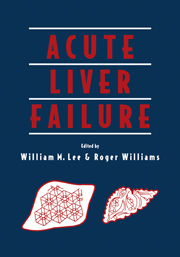Book contents
- Frontmatter
- Contents
- Preface
- Foreword
- Acknowledgments
- Contributors
- Part One Clinical Syndrome and Etiology
- 1 Classification and clinical syndromes of acute liver failure
- 2 Viral hepatitis and acute liver failure
- 3 Drug hepatoxicity as a cause of acute liver failure
- 4 Acetaminophen-induced acute liver failure
- 5 Unusual causes of acute liver failure
- 6 Pediatric aspects of acute liver failure
- Part Two Mechanisms of Disease and Multisystem Involvement
- Part Three Intensive Care Management
- Part Four Transplantation
- Part Five Artificial and Bioartificial Liver Devices
- Part Six Other Applications
- Index
- Plate section
3 - Drug hepatoxicity as a cause of acute liver failure
from Part One - Clinical Syndrome and Etiology
Published online by Cambridge University Press: 20 May 2010
- Frontmatter
- Contents
- Preface
- Foreword
- Acknowledgments
- Contributors
- Part One Clinical Syndrome and Etiology
- 1 Classification and clinical syndromes of acute liver failure
- 2 Viral hepatitis and acute liver failure
- 3 Drug hepatoxicity as a cause of acute liver failure
- 4 Acetaminophen-induced acute liver failure
- 5 Unusual causes of acute liver failure
- 6 Pediatric aspects of acute liver failure
- Part Two Mechanisms of Disease and Multisystem Involvement
- Part Three Intensive Care Management
- Part Four Transplantation
- Part Five Artificial and Bioartificial Liver Devices
- Part Six Other Applications
- Index
- Plate section
Summary
INTRODUCTION
Over 800 drugs have been reported to cause liver disease, and the spectrum of disease ranges from asymptomatic reversible transaminase elevations to fatal acute liver failure. Drug-induced liver disease can mimic almost any known liver disorder. Drug hepatotoxicity represents 2 to 3 percent of cases of jaundice, and is responsible for at least 10 to 20 percent of cases of acute liver failure (ALF); since no etiologic virus can be identified in 40–50 percent of cases of ALF, it is conceivable that some additional unknown proportion of these cases are due to drugs, natural toxins or environmental chemicals (Friis and Andreasen 1992; Dossing and Sonne 1993). Precise figures on the incidence of hepatic injury among recipients of most drugs are not available. Most of the information on drug-induced toxicity has come from individual case reports, series of cases, or reviews of the literature.
MECHANISMS OF INJURY
Drug metabolism
The liver is a major site for drug metabolism. The biotransformation of foreign substances into more polar metabolites which are more readily eliminated is classically described to occur in two phases. Phase I reactions are oxidations or reductions of chemicals by cytochrome P450 enzymes. Phase II reactions involve conjugation with glucuronic acid, sulfate, acetic acid or glutathione (GSH) to change the size and solubility of the drug. Phase I reactions may add or expose a functional group, such as hydroxyl, which then can serve as a structural locus for phase II conjugation.
- Type
- Chapter
- Information
- Acute Liver Failure , pp. 19 - 31Publisher: Cambridge University PressPrint publication year: 1996



